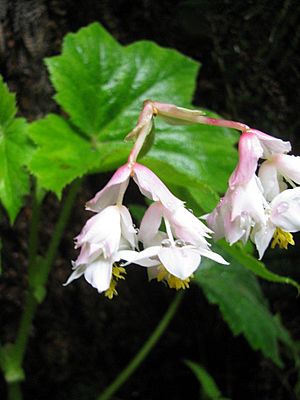Hillebrandia facts for kids
Quick facts for kids Hillebrandia |
|
|---|---|
 |
|
| Conservation status | |
| Scientific classification | |
| Genus: |
Hillebrandia
|
| Species: |
sandwicensis
|
Hillebrandia sandwicensis is a special kind of flowering plant that grows in Hawaii. It's a perennial plant, which means it lives for more than two years. People in Hawaii call it aka ʻaka ʻawa or puʻa maka nui. The plant's scientific name, Hillebrandia, honors a German doctor named William Hillebrand.
What It Looks Like
Hillebrandia sandwicensis looks a bit like a plant called Begonia. However, it has different flowers, pollen, and fruits. These differences show it belongs to its own unique group.
This plant grows tubers underground. Tubers are like thick, underground stems that store food. After the plant makes its fruit in the summer, the parts above the ground die back. The plant then rests, or goes into a dormant state, using the energy stored in its tubers.
New plants start to grow again in January. They bloom, or produce flowers, from February until June. The seeds of Hillebrandia sandwicensis are very tiny. Its branches are succulent, meaning they are thick and store water. This plant is also monoecious. This means it has both male and female flowers on the same plant.
Its Family Tree
Hillebrandia sandwicensis belongs to the plant family called Begoniaceae. It is the only species in its group, or genus, called Hillebrandia. This is very interesting because there are about 1900 other species in the Begoniaceae family, and all of them are part of the Begonia genus. Hillebrandia is the only one that isn't!
Scientists believe Hillebrandia is like a very old cousin to all the other plants in the Begoniaceae family. It split off from the main family tree a very long time ago. This happened even before the oldest Hawaiian island, Kure Atoll, was formed.
This makes scientists wonder how this unique plant ended up on a remote island chain that is much younger than the plant itself. One idea is that Hillebrandia "island-hopped" over time. It might have spread from older, now sunken, islands along the Hawaiian – Emperor seamount chain. Wind could have carried its seeds often enough for it to grow on each new island. This process might have been easier long ago. Back then, during the Cenozoic era, the climate was warmer. This allowed the plant to grow at lower elevations than it does today. It's also possible that Hillebrandia is not as old as some scientists first thought.
Where It Grows
Hillebrandia sandwicensis is the only plant from the Begonia family that naturally grows in the Hawaiian Islands. You can find it in wet, forest-covered valleys. It usually grows at high altitudes, between 900 and 1800 meters (about 3,000 to 6,000 feet) above sea level.
Today, this plant is only found on three Hawaiian islands: Maui, Molokai, and Kauai. It used to grow on Oahu, but it has disappeared from there. It has never been found on the Big Island. Even though there are many places that seem perfect for it, the plant is not very common and is found only in specific spots.
Recently, Hillebrandia sandwicensis has become rarer. However, as of 2020, it is not listed as an endangered species on the International Union for the Conservation of Nature's Red List. Still, a document from 1999 by the American Fish and Wildlife Service did list Hillebrandia sandwicensis as one of 202 "Other Species of Concern." This means they are watching it closely because its numbers are decreasing.
See also
 In Spanish: Hillebrandia para niños
In Spanish: Hillebrandia para niños


